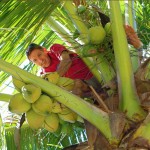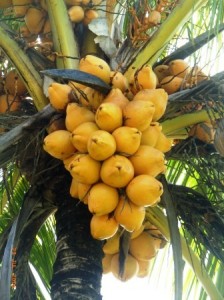Climbing and harvesting coconuts
Harvesting without climbing
Look up and see different generations of coconuts in bunches. The lowest stalks will have bunches closest to maturity. Though often it is the heaviest bunch which hangs the lowest. There is a new bunch every month and from about 6 months from pollination a rapid size increase occurs. Peak sugar concentration is usually around 8 -9months and the flesh turns from rubbery to firm from month 11-12 when full maturity is reached
Stages to distinguish
Mature. Oily water/milk, inner shell very hard, flesh no longer soft, Some drying of the outer husk. Still nice eating especially grated and cooked to release the oils. Inner shell is too hard for coco tapping, best to dehusk these on a sharp stick then use COCOTAP on the third eye which is the softest, and crack open the shell.
Ripe*. Sweet to bubbly rich liquid with soft but firm flesh up to 10 mm thick. Perfect for drinking and then cooking.
Jelly*. Sweet water, plus a layer of soft jelly meat 1-4 mm thick. Perfect for drinking.
Early. Very watery, little sugar, no flesh deposited. These often split on impact with the ground.
*these are the best for TAPing. The husk colour is not a reliable guide as there are so many varieties. Steer towards the second or third bunch from the top.
A pruning saw blade on the end of a long pole is the easiest way to remove an entire bunch. This can be done even from the top of a ladder but inevitablely, the coconuts bruise or even split if still at jelly stage. Its good to ensure a soft landing in any case, but best to climb into the crown of the palm and lower the whole bunch on a rope. This ensures maximum “shelf life” and studies show that a 8 months ripe coconut will continue to deposit flesh without losing flavour for up to 9 weeks if kept cool and attached to the stalk.
Using the COCOTAP to pluck a coconut
With the COCOTAP lashed tightly on the end of a long pole (bamboo is often available) you can “gaff hook” a ripe nut from below.
Simply drilling a hole straight through the bamboo by twisting the COCOTAP in at a slight angle. Then passing a rope through the cleaning port, lash the COCOTAP firmly in place.
The underside of the handle is sharp enough to loosen a nut or two from the stalk.
COCOTAP takes no responsibility for those who can’t avoid the flight path of a loose nut. Look up always! Clear the bystanders.
Ancient saying “The coconut has 3 eyes and thus knows who to hit and who to miss”
Coconuts may split if too young and will definitely bruise so consume within a couple of days for best flavours.
Warning if you try to drink from a nut split open in this way chances are it will get on your clothes. It stains clothing so best take off your shirt or prepare to bleach.








